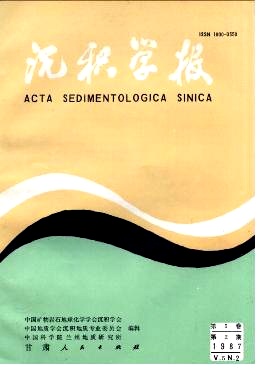THE PETROLOGICAL CHARACTERISTICS AND SEDIMENTARY FACIES ANALYSIS OF MIDDLE AND UPPER DEVONIAN SERIES IN DONGBO-PINGHE AREA, SOUTH OF HUNAN
- Received Date: 1985-03-28
- Publish Date: 1987-06-10
Abstract: In the studied area the outcroped strata are mainly three formations: the Middle Devonian Qiziqiao Formation ( D2q ) , the Upper Devonian Shetianqiao Formation ( D3S ) and Xikuangshan Formation ( D3x ) . According to its difference of lithologic character, each formation is subdivided into sevral members and sub-members. In the whole area there is few of terrigenous clastic rocks, carbonate rocks occupy mostly. The carbonate rocks consist of micrite ( including algal pellet micrite, laminated micrite, dolomitized micrite ) , arenitic micrite, sparry algal ooid limestone, sparry calcarenits, sparry bioclastic limestone etc..However the micri-tes constitute the main part, the other types of limestone are found in intercalations and these indicate that the rocks were generally formed in a environment of low energy. The texture origin components of limestonespellet, intraclast and terrigenous clastic quartz show the pulsatory variation and the organisms of algae are flourishing, these suggest that the rocks were formed in a tidal flat environment. Some limestones, especially in D2q, have been dolomitized and the origin of do lostone is explained in terms of seawater mixed with fresh water. This model also indirectly indicates that the rocks were formed in a tidal flat environment. Other evidences indicating their sedimentary environment are as follows: (l)wa-ter flow into two directions, such as beddings of fish bone, reactivation surface etc; ( 2 ) the mark of pulsative variation, such as lenticular bedding; ( 3 ) the indication of intermittant exposure, such as mud crack and birdeye structure. Based on above characteristics together with texture of sections and characteristics of sedimentary geochemistry, the sedimentary facies of this area can be classified into three facies zones; namely, coastal facies zone, restricted platform facies zone and open platform facies zone. The first zone is composed of terrigenous detritus beach facies. The second is subdivided into intertidal mud flat facies in turbid water, intertidal mud flat facies in clear water, intertidal mixed flat facies, tidal ditch facies and tidal beach facies. The third consists of the shallow water in subtidal zone. The study on the relationship of element assemblage gives a complementary evidence for analysis of sedimentary facies. In factor analysis of R type, three factors F1, F2 and F3 are taken. F1 apparently reveals the fact of turbid water deposit and clear water deposit alternately appeared in this area; F2 suggests a variation from shallow water to deep water and from low to high salt content in the tidal environment, F3 indicates the turbid water of carbonate flat suppress growing of organism. In factor analysis of Q type, the first three principal factors g1, g2 and g3 are also taken. All-bulk of the samples loading on the axis of fac-ttor g1 are larger, which shows the sedimentary area is to be a tidal environment ( because the samples of terrigenous detritus beach facies are not participated in the analysis ) . According to sedimentary facies, samples on the axis of factor g2 are evidently distributed. On one hand, it indicates that the geological significance of g2 is to place emphasis on the hydrodynamical variation resulting different facies types, on the another hand it indirectly suggests that the diagenetic environment is not a completely open system. The informations of primarily sedimentary environment are partly reserved, and thus characteristics of sedimentary geochemistry may be used as a complementary evidence of sedimentary facies. Sample loadings on the axis of factor g3 are more scattered, which reveals the characteristics of transitional facies from sea to continent. The vertical variation of sedimentary facies results from the lateral shift and overlap of laterally neighbouring facies. On the basis of this, a comprehensive sedimentary facies model of Dongbo-Pinghe area in the Middle and Late Devonian is established.
| Citation: | Ren Xiekang, Yang Chuxiong, Ding Chuanpu. THE PETROLOGICAL CHARACTERISTICS AND SEDIMENTARY FACIES ANALYSIS OF MIDDLE AND UPPER DEVONIAN SERIES IN DONGBO-PINGHE AREA, SOUTH OF HUNAN[J]. Acta Sedimentologica Sinica, 1987, 5(2): 81-90. |






 DownLoad:
DownLoad: